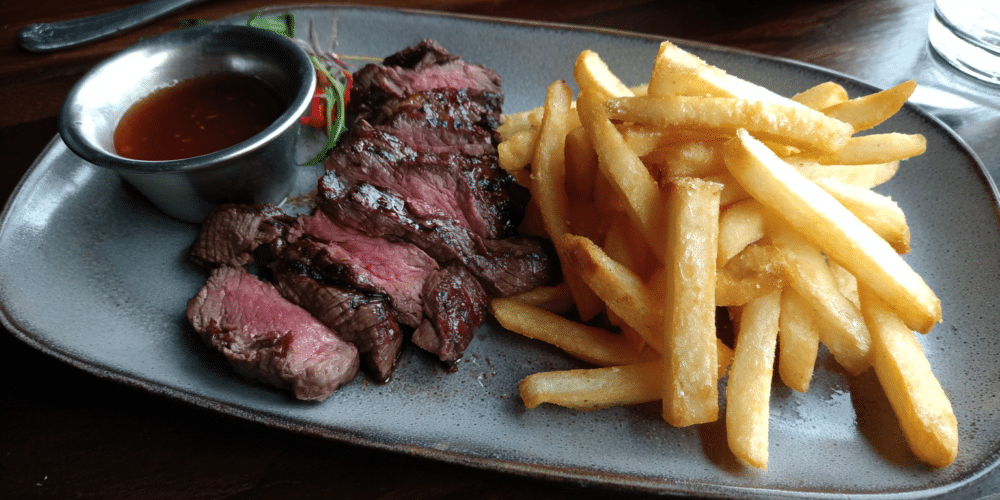
Meat can be a fantastic source of fuel for our bodies. It’s packed with protein, which is super important for fixing up our muscles, bones, and organs. Plus, it’s one of the main places we get vitamin B12, which is pretty essential for our nerves to work right. Many meats also give us micronutrients like iron, zinc, and selenium, which help with energy, our immune system, making DNA, and forming red blood cells.
But, and this is a big but, not all meat is created equal. The issue with certain types of meat is that they can contain harmful chemicals and compounds that cause inflammation. These can lead to cell damage, glycation, and a bunch of problems that contribute to things like clogged arteries and other diseases. The goal here is to help you stay healthy and happy, even while enjoying your favorite meals. Sometimes, just a few simple changes can make a big difference.
7. Poorly Raised Beef

The way cattle are raised can really change the nutrition in the beef you eat. It’s not always easy to tell if your beef is healthy or not. A big problem is when cows are fed grains, mostly corn and soy. This isn’t what cows naturally eat. While it might be cheaper and helps them gain weight faster, it results in beef that’s lacking in nutrients and has an imbalance of fatty acids.
Grain-fed beef usually has less of the good omega-3 fatty acids and more omega-6 fatty acids. When the balance between omega-3 and omega-6 is off, it’s linked to various health issues, including inflammation, heart problems, and even some types of cancer.
A study back in 2010 looked at the fatty acid profiles and antioxidant content in both grass-fed and grain-fed beef. It found that grass-fed beef not only has more omega-3s but also higher levels of things that help make vitamin A and vitamin E. It’s also richer in antioxidants like glutathione and superoxide dismutase, which help fight cancer. This shows that it’s not just about omega-3s, but the whole package of nutrients you get from animals eating their natural diet.
The living conditions of cattle also affect the meat quality. Cows kept in crowded factory farms are often in unhealthy environments. This can lead to more diseases spreading among them, meaning they get more antibiotics. These stressful conditions can also increase cortisol levels, which can result in lower-quality meat. High cortisol in animals might even contribute to chronic diseases in humans.
On the flip side, cattle that graze on pasture can move around freely and act naturally. This leads to better health for the animals and, consequently, healthier meat for us.
So, how can you know what you’re buying? Look for labels that say the beef is grass-fed. If there’s no label, ask the butcher. Also, try to find beef from farms that care about animal welfare and sustainable practices. It might take a bit of searching, but it’s worth it.
6. Eel Meat

Eel is often seen as a fancy food, loved for its rich, buttery taste in dishes like grilled eel or eel soup. However, recent research has uncovered some concerning issues with this popular food. Scientists have found that eel can contain toxins that pose significant risks.
One study examined eel samples from many locations in Belgian rivers and lakes. The results were surprising: eels from a large percentage of these sites had contamination from toxic dyes used in clothing. These chemicals, coming from the clothing and textile industries, get into the water and then into the eels’ tissues.
Eel populations in Taiwan have also raised concerns due to high levels of cadmium. Cadmium is a heavy metal that comes from industries like electroplating. Exposure to it can cause serious health problems, including bone softening and kidney damage.
Other studies have found flame retardants and plasticizers in eels meant for people to eat. These chemicals are used in products like TVs and smartphones, but they’re harmful if you eat them. They build up in your body over time and have been linked to health issues like hormone disruption and cancer.
So, even though eel can be delicious, it might carry a concerning amount of toxins because of pollution. It’s important to understand where our food comes from and how environmental factors can affect it.
5. Conventionally Raised Chicken

Chicken is a popular and lean protein. However, the way chickens are raised today can turn a healthy protein into something potentially harmful. Most chickens are now kept in crowded spaces and don’t get a natural diet. Free-range chickens, on the other hand, have access to outdoor areas and more natural living conditions.
These crowded conditions can lead to a higher risk of diseases spreading among the chickens, which often means more antibiotics are used. While antibiotics are needed to treat illnesses, overuse can have negative effects. Antibiotic residues can remain in the meat, contributing to antibiotic resistance in humans, which is a growing global health problem.
Have you ever noticed how large chicken breasts are in the store? That’s not natural. Antibiotics are also used to promote growth. A report from the World Health Organization found that a large percentage of antibiotics given to animals were for growth promotion, not just treating illnesses. They’re essentially using antibiotics to make chickens grow faster and bigger. This overuse of antibiotics can make important medicines less effective, leading to harder-to-treat infections in people.
Furthermore, non-organic chickens are usually fed genetically modified corn and soy. Like with grain-fed beef, this results in lower amounts of beneficial omega-3 fatty acids and other key nutrients.
When it comes to eggs, there’s a big difference between those from free-range hens and caged hens. Free-range eggs contain much more vitamin D, which is important for calcium absorption, mental health, immunity, and more. It makes sense: free-range chickens spend time in the sun, unlike those cooped up inside.
Free-range eggs also have higher levels of omega-3s, folic acid, chlorophyll, and vitamin B12, making them a much healthier choice. It seems that if we choose the cheapest food possible, we might end up harming our health and paying a higher price in the long run.
4. Salami, Bacon, and Bologna

Several studies have found a connection between processed meats and diseases. The more processed meat you eat, the higher your risk. For example, one study followed people for over nine years and found that eating about 150 grams of processed meat per week was linked to a significantly higher risk of heart disease and death from any cause compared to those who ate no processed meat.
Processed meats often contain nitrites and harmful compounds like trans fats and spermine. In products like bologna, trans fats can make up a noticeable portion of its composition. Trans fats are linked to many health concerns, including heart disease, diabetes, and faster aging. Spermine is a compound that’s thought to form colon polyps, which can lead to colon cancer.
Nitrites are used to prevent bacterial growth and reduce the risk of food poisoning. However, once inside our bodies, nitrites can turn into nitrosamines, which are known carcinogens. Nitrites and nitrosamines from processed meats are linked to an increased risk of several cancers, including bladder, prostate, and thyroid cancer. Some studies also suggest a link between nitrite consumption and chronic obstructive pulmonary disease (COPD).
Given all this evidence, processed meats like salami, bacon, and bologna should probably come with a warning label.
What are some healthier alternatives? If you like the convenience and flavor, try choosing whole cuts of meat. Whole deli meats like roast beef, turkey, or chicken are usually healthier. These are made from a single piece of meat and are often cooked and sliced in the store, rather than being preserved with additives. They tend to have fewer added ingredients and are less processed.

